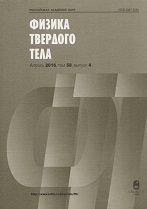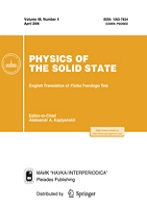|
Dielectrics
Hyperfine interactions in copper lattice sites of antiferromagnetic compounds representing the analogues of superconducting copper metal-oxide compounds
E. I. Terukovab, A. V. Marchenkoc, F. S. Nasredinovd, A. A. Levina, A. A. Luzhkovc, P. P. Sereginc
a Ioffe Institute, St. Petersburg
b Saint Petersburg Electrotechnical University "LETI"
c Herzen State Pedagogical University of Russia, St. Petersburg
d Peter the Great St. Petersburg Polytechnic University
Abstract:
Emission $^{61}$Cu($^{61}$Ni) Mössbauer spectra of dielectric metal-oxide compounds of divalent copper with molecular formulas Ca$_{1-x}$Sr$_{x}$CuO$_{2}$, Ca$_{2}$CuO$_{2}$Cl$_{2}$, SrCuO$_{2}$, Sr$_{2}$CuO$_{2}$Cl$_{2}$, YBa$_{2}$Cu$_{3}$O$_{7-x}$, La$_{2-x}$Sr$_{x}$CuO$_{4}$, Nd$_{2-x}$Ce$_{x}$CuO$_{4}$ correspond to the quadrupole and Zeeman interactions of the 61Ni nuclei with local fields at the copper lattice sites, whereas the spectra of superconducting metal-oxide complexes correspond to the interaction of the quadrupole moment of the $^{61}$Ni nuclei with the tensor of the electric field gradient (EFG). For both groups of metal oxides, linear dependences of the quadrupole interaction constants on the calculated values of the principal component of the lattice EFG tensor in the copper lattice sites are observed both on the $^{61}$Ni nuclei (data of the emission Mössbauer spectroscopy on the $^{61}$Cu($^{61}$Ni) isotopes) and on the $^{63}$Cu nuclei (data of the nuclear magnetic resonance on the $^{63}$Cu isotope). This fact is explained by the constant values of the valence component of the EFG for both the $^{61}$Ni$^{2+}$ and $^{63}$Cu$^{2+}$ probes in all metal-oxide complexes of divalent copper.
Keywords:
antiferromagnetics, high temperature superconductors. emission Mössbauer spectroscopy, NMR, electric field gradient tensor.
Received: 14.10.2019
Revised: 14.10.2019
Accepted: 29.10.2019
Citation:
E. I. Terukov, A. V. Marchenko, F. S. Nasredinov, A. A. Levin, A. A. Luzhkov, P. P. Seregin, “Hyperfine interactions in copper lattice sites of antiferromagnetic compounds representing the analogues of superconducting copper metal-oxide compounds”, Fizika Tverdogo Tela, 62:3 (2020), 381–385; Phys. Solid State, 62:3 (2020), 431–435
Linking options:
https://www.mathnet.ru/eng/ftt8466 https://www.mathnet.ru/eng/ftt/v62/i3/p381
|


| Statistics & downloads: |
| Abstract page: | 62 | | Full-text PDF : | 27 |
|





 Contact us:
Contact us: Terms of Use
Terms of Use
 Registration to the website
Registration to the website Logotypes
Logotypes









 Citation in format
Citation in format 